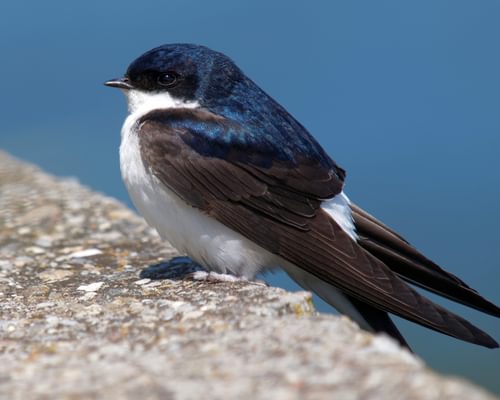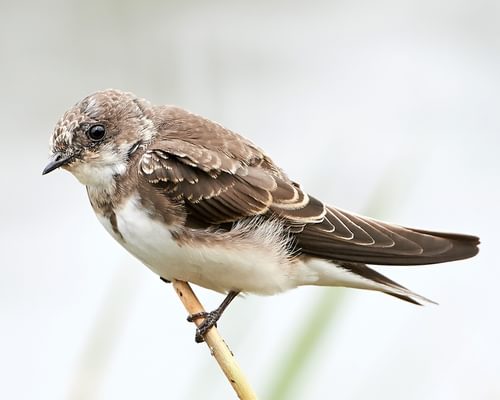Barn Swallow
Least ConcernHirundo rustica
Visual Identification
Appearance
The Barn Swallow is a sleek, small bird with a distinctive deeply forked tail and long, pointed wings. Its upperparts are glossy steel-blue, contrasting with a rusty-red forehead and throat. The underparts are buffy to white, often with a reddish wash.
Males typically have longer tail streamers and more vibrant coloration than females. Juveniles are duller, with shorter tails and a paler throat.
Size
Length
17cm to 19cm
Wingspan
32cm to 34cm
Weight
16g to 22g
Habitat and Distribution
Habitats
Woodland
Garden
Wetland
Coastal
Urban
Farmland
Grassland
Desert
Tundra
Rainforest
Mountain
Savanna
Distribution
Barn Swallows have a nearly global distribution, breeding across much of the Northern Hemisphere and wintering in the Southern Hemisphere. They prefer open habitats near water, including farmlands, meadows, and suburban areas.
They are common summer visitors to the UK, USA, and Canada and can be found year-round in parts of Australia. Their adaptability to human structures has allowed them to thrive in diverse environments.
Elevation Range
Sea level to 3,000 meters
Climate zones
Temperate, Subtropical, Tropical
Distribution Map
This map gives you a rough idea of where you might spot a Barn Swallow. The coloured areas show countries where these birds have been seen.
A few things to keep in mind:
- Birds might not be everywhere in the coloured areas, for example, they may be present around the coast of that country
- Where birds live can change with seasons and available food
- This map is quite simple - it doesn't show exact locations
We're working on making our maps even better! Soon, we hope to show you:
- More detailed maps for bigger countries, including state and region
- How birds move around during different seasons
Distribution by Region
Behaviour and Ecology
Bird Attributes
This feature is in beta. We'd love your feedback to improve it!
Share your thoughtsBird Attributes Explained
Our bird attributes system rates various aspects of a bird's capabilities on a scale of 0-100, based on data from field observations, scientific studies, and expert knowledge.
Attribute Categories:
- Agility: Manoeuvrability, speed, and grace in flight or movement.
- Strength: Physical power, often correlating with size and hunting abilities.
- Adaptability: Ability to thrive in various environments or changing conditions.
- Aggressiveness: Territorial behaviour and assertiveness, particularly during breeding seasons.
- Endurance: Stamina, often seen in migration patterns or foraging behaviours.
Understanding the Ratings:
- 0-20: Very Low
- 21-40: Low
- 41-60: Average
- 61-80: High
- 81-100: Very High
Remember, these attributes are relative to other bird species and don't necessarily indicate superiority.
Hover over the icon next to each attribute for more information.
Tap the icon next to each attribute for more information.
Agility
Reflects the bird's manoeuvrability, speed, and grace in flight or movement.
The Barn Swallow is renowned for its exceptional agility, performing intricate aerial manoeuvres to catch insects mid-flight. Their deeply forked tail and long, pointed wings enable swift, graceful movements, making them true masters of the air.
Strength
Indicates the bird's physical power, often correlating with size and hunting abilities.
Whilst not particularly strong in terms of raw power, Barn Swallows possess enough strength for their size to build mud nests and carry out long-distance migrations. Their strength is more focused on endurance than brute force.
Adaptability
Represents the bird's ability to thrive in various environments or changing conditions.
Barn Swallows demonstrate remarkable adaptability, thriving in diverse habitats from sea level to 3,000 metres elevation. Their ability to nest in human structures and adjust to various environments across multiple continents showcases their high adaptability.
Aggressiveness
Measures the bird's territorial behaviour and assertiveness, particularly during breeding seasons.
Generally non-aggressive towards humans, Barn Swallows can display territorial behaviour during breeding season. They may mob predators to protect their nests but are not typically considered an aggressive species compared to many other birds.
Endurance
Reflects the bird's stamina, often seen in migration patterns or foraging behaviours.
Barn Swallows exhibit impressive endurance, undertaking long-distance migrations of up to 11,000 km. Their ability to fly continuously for extended periods, catching insects on the wing and even drinking and bathing mid-flight, demonstrates exceptional stamina.
Diet
Barn Swallows are insectivores, primarily feeding on flying insects such as flies, moths, and beetles. They catch their prey in mid-air, often flying low over fields or water bodies. They'll also eat flying ants, moths, and beetles.
During the breeding season, they may consume up to 60 insects per hour to sustain their high energy needs.
Behaviour
Barn Swallows are highly social birds, often seen in large flocks during migration and winter. They are agile flyers, catching insects on the wing with swift, graceful movements.
These birds frequently perch on wires or branches, chattering amongst themselves and preening.
Vocalisation
Barn Swallows are known for their cheerful, twittering song, often described as a series of liquid chirps and warbles. Their call is a sharp 'vit' or 'vit-vit'. During the breeding season, males sing more elaborately, producing a pleasant, bubbling warble that sounds like 'weet-weet-wittit-wittit-wittit'.
They also produce alarm calls when they detect a threat and when attempting to deter predators from the nest.
Nesting & Breeding
Barn Swallows typically form monogamous pairs, with breeding occurring from spring to early summer. Courtship involves aerial displays and melodious duets.
Nests are cup-shaped structures made of mud pellets mixed with grass, lined with feathers. They are often attached to rafters in barns or under bridges. Females lay 4-5 white eggs with reddish-brown spots.
Incubation lasts about 14-19 days, with both parents sharing duties. Nestlings fledge after 18-23 days but remain dependent on their parents for up to a week after leaving the nest.
Lifespan
The Barn Swallow typically lives for 2 years, with a maximum recorded lifespan of 11.1 years.
Like all birds, lifespan can be affected by factors including predation, habitat quality, disease, and access to food sources.
Conservation and Status
Global Conservation Status
While globally listed as Least Concern, Barn Swallow populations have declined in some regions due to agricultural intensification and loss of nesting sites.
Conservation efforts focus on maintaining suitable nesting habitats and reducing pesticide use in foraging areas.
Birdwatching Tips
- Look for Barn Swallows near open fields, farmlands, and water bodies.
- Observe their distinctive forked tails during flight.
- Listen for their cheerful, twittering calls, especially near nesting sites.
- In the UK and North America, check barns and outbuildings for nesting pairs in spring and summer.
Additional Information
Quick Facts
Other names:
European Swallow, Common Swallow
Family:
HirundinidaePredators
Did You Know?
- Barn Swallows can drink and bathe on the wing, skimming the water's surface.
- They often return to the same nesting site year after year, travelling up to 11,000 km during migration.
- In many cultures, Barn Swallows symbolise good luck and heralds of spring.
Was this bird profile helpful?
Your feedback helps us improve our content
Thanks for your feedback!
Your input helps us improve our content.
Community Experience
Community Ratings
No ratings yet - be the first to rate this bird!
Latest Community Reviews
No reviews yet
Sign in to be the first to review
Community Reviews
Create Your Free Account Welcome Back!
Join our community to rate birds and share your experiences. Creating an account is completely free and only takes a minute. Sign in to your account to rate birds and share your experiences with our community.
Your information is secure and will never be shared.
By creating an account, you agree to our Privacy Policy.
FAQs
What is special about a Swallow bird?
The Swallow’s impressive annual migration is one of its most fascinating behaviors. These tiny birds switch between the Northern and Southern Hemispheres each year to take advantage of the alternating spring and summer seasons on either side of the equator. They can fly over a hundred miles in a day and may have to fly even further when crossing open stretches of the ocean.
Are Swallows good to have around your house?
Homeowners do not always appreciate Swallows. Their mud nest and droppings make them unpopular with some people, although their presence also has some great benefits. These birds are highly effective at controlling small flying insects like mosquitoes and other pests.
Similar Birds
References
- 2 3 4
website: BirdLife International. 2019. Hirundo rustica. The IUCN Red List of Threatened Species 2019: e.T22712252A137668645.
View source - 1
website, 2010: Fransson et al., EURING list of longevity records for European birds
View source


